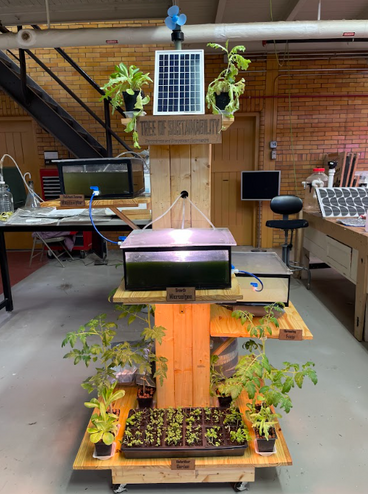
Engineering a sustainable future
BY LOUISA SMITH, AGRICULTURAL COMMUNICATION & MARKETING, BS '25

Growing up reading her father’s scientific digest magazines, Ana Beatriz Lobo-Moreira established her interest in environmental science from a young age. Surrounded by the nature of Brazil, she applied what she was reading from the Brazilian Ciência Hoje (Today’s Science) and the Scientific American to the world around her, fostering her strong connection to nature.
“I’ve always had a very internal feeling of belonging to nature, even though we are raised as if we were superior to any other living organism” Lobo-Moreira said.
Today Lobo-Moreira has achieved a bachelor's degree in biology, a masters degree in environmental engineering, and is in her final year pursuing PhD in environmental science.
Lobo-Moreira took her studies to the University of Minnesota for the 2023-2024 school year, hosted by Professor Roger Ruan and his team of research scholars in the Department of Bioproducts and Biosystems Engineering (BBE). She spent this time developing a research project called the “Tree of Sustainability” alongside BBE researcher David Schmidt.

“The idea is to create a sequential or series production aiming to reach some level of circular economy, in which nothing is wasted,” Lobo-Moreira said. “The whole concept was designed to be built outdoors, sunlight should be used for algae growth, and electricity to electric devices, but in our pilot, we made an indoor version.”
Building on previous waste-recycling concepts, like using manure as fertilizer, Lobo-Moreira believes microalgae is one of the most effective groups of organisms in photosynthesis. The Tree of Sustainability aims to utilize microalgae-based bioproducts in five main ways.
- Wastewater treatment: tested on municipal water from St. Paul wastewater treatment plant and anaerobic effluent from a food waste digester on the Makerspace.
- Microalgae biomass production: using wastewater as a nutrient provider to produce biomass that can be used as biofuel, biofertilizer, or another bioproduct.
- Harvesting: using fungi in a process called bioflocculation to remove microalgae from the media, concentrating the biomass and increasing its organic loads adding fungi nutrients to the system.
- Biogas production: feeding the anaerobic digester with microalgae-fungi biomass in co-digestion with cattle manure to increase the methane yield. The gas produced can provide energy to feed the system.
- Biofertilizer: using anaerobic digestate and microalgae biomass as biofertilizer on food crops.
“[The Tree of Sustainability] is a very simple representation that we can transform our residues into something new, both in our own houses or in big industries,” Lobo-Moreira said. “It reproduces a residue treatment, producing biomass for energy generation.”
Lobo-Moreira’s next goal is to publish the results of the experiments run on the “Tree of Sustainability.”
“During my time [at the University of Minnesota], I focused on expanding every aspect of my research by fostering collaborations, participating in conferences, and creating opportunities to highlight the importance of our work,” Lobo-Moreira said.
The tree of sustainability is a model that applies far beyond its current practice. Inspired by her childhood, Lobo-Moreira hopes to transform her father’s rural property into an “eco-friendly retreat” where visitors can connect to nature and learn sustainable practices to protect it.





